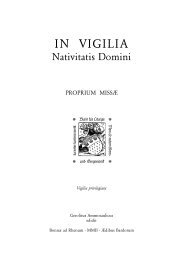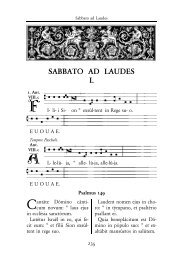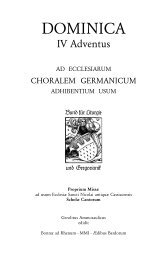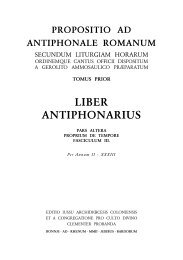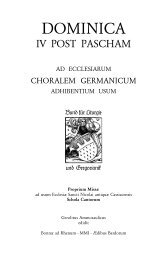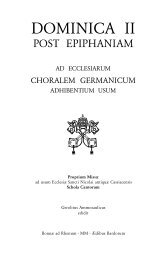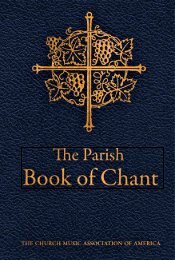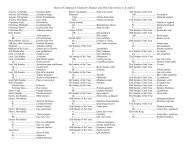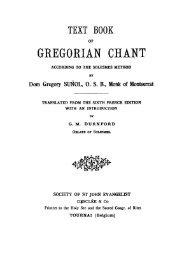The Bugnini-Liturgy and the Reform of the Reform - MusicaSacra
The Bugnini-Liturgy and the Reform of the Reform - MusicaSacra
The Bugnini-Liturgy and the Reform of the Reform - MusicaSacra
You also want an ePaper? Increase the reach of your titles
YUMPU automatically turns print PDFs into web optimized ePapers that Google loves.
2. <strong>The</strong> formation <strong>of</strong> <strong>the</strong> Roman Office<br />
Perhaps <strong>the</strong> most mature construction in <strong>the</strong> realm <strong>of</strong> Office varieties is<br />
<strong>the</strong> proper Office <strong>of</strong> Rome. Its elements were ready by <strong>the</strong> 4 th , or at <strong>the</strong> latest,<br />
by <strong>the</strong> 5 th century. When St. Benedict <strong>of</strong> Nursia gave an Office to his<br />
monks (beginning <strong>of</strong> 6 th century), he had no more to do than to adapt <strong>the</strong><br />
Roman Office to <strong>the</strong> living conditions <strong>of</strong> <strong>the</strong> monastery. This 4 th -5 th -century<br />
form <strong>of</strong> <strong>the</strong> Roman Office has been augmented during <strong>the</strong> subsequent<br />
centuries, <strong>and</strong> it eventually gave birth to a great family <strong>of</strong> various related<br />
Offices, while in essence it remained unchanged up until <strong>the</strong> 20 th century.<br />
What is meant by <strong>the</strong> term "Roman Office" is this 1500-year old structure,<br />
yet not any one individual form <strong>of</strong> it (like <strong>the</strong> Tridentine Office), but <strong>the</strong> totality<br />
expressed in <strong>the</strong> rites <strong>of</strong> dioceses <strong>and</strong> religious orders. In this sense it<br />
can be said that <strong>the</strong> Roman Office - originated in <strong>the</strong> 4 th or 5 th century -<br />
was deadly wounded around 1900, <strong>and</strong> ceased to exist in 1970.<br />
We are now going to describe briefly <strong>the</strong> essential features <strong>of</strong> this Roman<br />
Office. 5<br />
2.1. <strong>The</strong> "natural" character <strong>of</strong> <strong>the</strong> Roman Office is a result <strong>of</strong> an organic<br />
development that did not conceal <strong>the</strong> traces <strong>of</strong> historically diverse'<br />
components or <strong>the</strong> different roots <strong>of</strong> <strong>the</strong> Hours, in spite <strong>of</strong> <strong>the</strong> necessary<br />
unification. Lauds <strong>and</strong> Vespers, <strong>the</strong> Vigil <strong>and</strong> <strong>the</strong> group <strong>of</strong> daytime Little<br />
Hours sensibly differ in length, structure <strong>and</strong> atmosphere.<br />
<strong>The</strong> Vigil consists <strong>of</strong> <strong>the</strong> alternation <strong>of</strong> longer psalmody <strong>and</strong> reading ir<br />
accordance with <strong>the</strong> longer night watch <strong>and</strong> its contemplative character,<br />
<strong>The</strong> Hour is preceded by <strong>the</strong> invitatory, which does not belong to <strong>the</strong> beginning<br />
<strong>of</strong> <strong>the</strong> astronomical day, ra<strong>the</strong>r it is a proportionate introduction <strong>of</strong> <strong>the</strong><br />
longer Hour <strong>and</strong>, at <strong>the</strong> same time, <strong>the</strong> overture <strong>of</strong> <strong>the</strong> liturgical day started<br />
by <strong>the</strong> Vigil.<br />
Lauds <strong>and</strong> Vespers are <strong>the</strong> most "liturgical" Hours: <strong>the</strong>ir dominating element<br />
is praise; <strong>the</strong> ceremonial elements <strong>of</strong> <strong>the</strong> ancient "Folk <strong>of</strong>fice" survived<br />
mostly in <strong>the</strong>se two Hours. <strong>The</strong>ir perfect construction with a stead}'<br />
build-up from <strong>the</strong> Old Testament psalms through <strong>the</strong> reading <strong>of</strong> <strong>the</strong> Bible<br />
up to <strong>the</strong> hymn, <strong>the</strong> New Testament canticle <strong>and</strong> <strong>the</strong> collect is not only<br />
composed with a perfect dramatic <strong>and</strong> psychological sense, but it also expresses<br />
<strong>the</strong> <strong>the</strong>ological idea <strong>of</strong> man's salvation proceeding from prophecy to<br />
5 <strong>The</strong> description refers primarily to its "secular" form (used in dioceses).<br />
48




